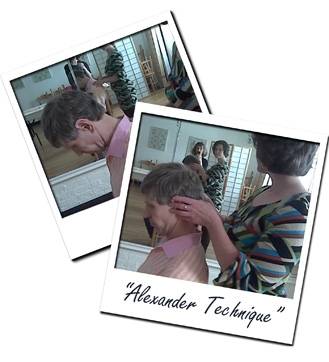 Alexander Technique is a method of re-educating and connecting with your body based on principles formulated by F. Matthias Alexander between 1890 and 1900. Popular among those in the performance arts (dancers, actors, musicians), Alexander Technique “is used remedially to regain freedom of movement… to undo the establishment of nuisance habits by performers, and as a self-awareness discipline and self-help tool to change specific habits, (and to) alleviate pain and weakness as a result of poor posture or repetitive physical demands, improve pain management for chronic disabilities, and rehabilitation following surgery or injury.” (Source: Wikipedia)
Alexander Technique is a method of re-educating and connecting with your body based on principles formulated by F. Matthias Alexander between 1890 and 1900. Popular among those in the performance arts (dancers, actors, musicians), Alexander Technique “is used remedially to regain freedom of movement… to undo the establishment of nuisance habits by performers, and as a self-awareness discipline and self-help tool to change specific habits, (and to) alleviate pain and weakness as a result of poor posture or repetitive physical demands, improve pain management for chronic disabilities, and rehabilitation following surgery or injury.” (Source: Wikipedia)
While Alexander Technique is about much more that pose and posture, its focus on self-perception and self-awareness of body use makes it an excellent tool for developing a relaxed and energizing posture.
Why are we talking about Alexander Technique? Because I’m seeing an Alexander Techinque practioner to improve my posture. I am blessed with a wife who is a dancer, a professional ballerina for decades. Posture, how you carry yourself, how you project your energy, and body lines all are as natural to her as organizational behavior, NOI, cap rates, and IRRs are to me.
Evidently my posture resembles the Hunchback of Notre Dame when I read my Blackberry. Since I spend significant time establishing rapport with my Blackberry and the Hunchback of Notre Dame is not my physical ideal, I’m learning how to look down using just my eyes and head (good) and not my neck and shoulders (bad). (See photos.)
Alexander Technique uses rich visualization. To help maintain correct posture, I’m to envision a mighty fountain shooting a bolt of water straight up into the air (this is my body and spine) with my head resting easily, like a soccer ball, on top of the column of water.
Closing Quotes:
“I want to get old gracefully. I want to have good posture, I want to be healthy and be an example to my children.” — Sting (Gordon Sumner)
“Unless some misfortune has made it impossible, everyone can have good posture.” — Loretta Young
“A good stance and posture reflect a proper state of mind.” — Morihei Ueshiba, martial artist and founder of Aikido (1883-1969).

